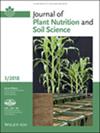XANES 光谱证明了酸性土壤中铁氧氢氧化物和蒙脱石对 P 的吸附分区与 pH 值有关
IF 2.8
3区 农林科学
Q1 AGRONOMY
引用次数: 0
摘要
背景铁和铝氧氢氧化物是土壤中众所周知的含磷(P)矿物。有关粘土矿物在氧氢氧化物-粘土矿物混合体系中吸附磷的相关性以及 pH 值对磷吸附分配的影响的信息很少。我们量化了在不同 pH 值(3-6)下,铁氧氢氧化物或鹅卵石与铝饱和蒙脱石(Al-MT)对正磷酸盐(oPO4)和肌醇六磷酸(IHP)保留的相对贡献。我们将 P 溶液浓度变化分析与通过 X 射线吸收近边结构(XANES)光谱分析氢氧化铁/Al-MT 混合物中与铁(III)和铝结合的 P 的定量分析相结合。在磷溶液浓度较低时,则观察到与此相反的情况。随着 pH 值的升高,铝镁土和铁氧氢氧化物对 oPO4 的截留作用也随之增加。这归因于粘土吸附的铝从单体 Al3+ 到多核铝羟基物种的形态变化。在 pH 值为 3-6 时,IHP 主要被 Al-MT 而不是铁酸盐所保留,这可能是由于形成了吸附和表面沉淀的植酸铝复合物。这些矿物的土壤钾保留分区取决于:(1) 主要的钾形式(oPO4、IHP);(2) 高活性粘土矿物、短程有序铁氧氢氧化物和结晶铁氧氢氧化物的相对丰度;(3) 溶液 pH 值。本文章由计算机程序翻译,如有差异,请以英文原文为准。
XANES spectroscopy proofs pH‐dependent P sorption partitioning to Fe oxyhydroxides versus montmorillonite in acidic soils
BackgroundFe and Al oxyhydroxides are well‐known phosphorus (P)‐retaining minerals in soils. Little information is available regarding the relevance of clay minerals for the sorption of P in mixed oxyhydroxide–clay mineral systems and pH effects on P sorption partitioning.Aims and MethodsWe wanted to investigate pH effects on P sorption partitioning between Fe oxyhydroxides and high‐activity clay minerals in mixed‐mineral systems. We quantified the relative contribution of ferrihydrite or goethite versus Al‐saturated montmorillonite (Al‐MT) to the retention of orthophosphate (oPO4 ) and inositol hexakisphosphate (IHP) at different pH values (3–6). We combined the analysis of P solution concentration changes with the quantification of P bound to Fe(III) versus Al in the Fe oxyhydroxide/Al‐MT mixtures by X‐ray absorption near‐edge structure (XANES) spectroscopy.ResultsOrthophosphate was preferentially retained by ferrihydrite, compared to Al‐MT at pH 3–6. The opposite was observed for goethite at low P solution concentrations. The contribution of Al‐MT versus Fe oxyhydroxides to oPO4 retention increased with pH. This is attributed to a speciation change of clay‐adsorbed Al from monomeric Al3+ to polynuclear Al hydroxy species. IHP was predominantly retained by Al‐MT rather than ferrihydrite at pH 3–6, probably by the formation of adsorbed and surface‐precipitated Al phytate complexes.ConclusionsSynchrotron‐based XANES spectroscopy allows for quantifying P adsorbed to co‐existing pedogenic Fe(III) oxyhydroxides versus Al‐MT in mixed‐mineral systems. Soil P retention partitioning to these minerals depends on (1) dominating P form (oPO4 , IHP), (2) relative abundance of high‐activity clay minerals, short‐range ordered and crystalline Fe oxyhydroxides, and (3) solution pH.
求助全文
通过发布文献求助,成功后即可免费获取论文全文。
去求助
来源期刊
CiteScore
4.70
自引率
8.00%
发文量
90
审稿时长
8-16 weeks
期刊介绍:
Established in 1922, the Journal of Plant Nutrition and Soil Science (JPNSS) is an international peer-reviewed journal devoted to cover the entire spectrum of plant nutrition and soil science from different scale units, e.g. agroecosystem to natural systems. With its wide scope and focus on soil-plant interactions, JPNSS is one of the leading journals on this topic. Articles in JPNSS include reviews, high-standard original papers, and short communications and represent challenging research of international significance. The Journal of Plant Nutrition and Soil Science is one of the world’s oldest journals. You can trust in a peer-reviewed journal that has been established in the plant and soil science community for almost 100 years.
Journal of Plant Nutrition and Soil Science (ISSN 1436-8730) is published in six volumes per year, by the German Societies of Plant Nutrition (DGP) and Soil Science (DBG). Furthermore, the Journal of Plant Nutrition and Soil Science (JPNSS) is a Cooperating Journal of the International Union of Soil Science (IUSS). The journal is produced by Wiley-VCH.
Topical Divisions of the Journal of Plant Nutrition and Soil Science that are receiving increasing attention are:
JPNSS – Topical Divisions
Special timely focus in interdisciplinarity:
- sustainability & critical zone science.
Soil-Plant Interactions:
- rhizosphere science & soil ecology
- pollutant cycling & plant-soil protection
- land use & climate change.
Soil Science:
- soil chemistry & soil physics
- soil biology & biogeochemistry
- soil genesis & mineralogy.
Plant Nutrition:
- plant nutritional physiology
- nutrient dynamics & soil fertility
- ecophysiological aspects of plant nutrition.

 求助内容:
求助内容: 应助结果提醒方式:
应助结果提醒方式:


